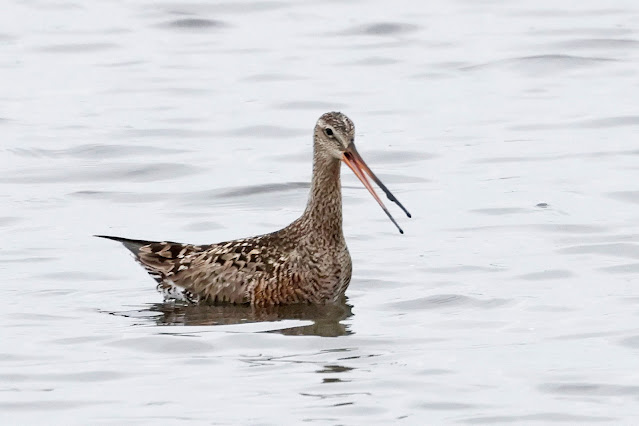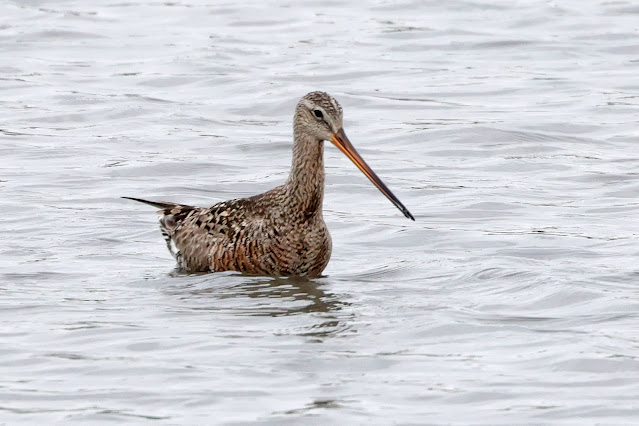Sitting in the departure lounge at Chania airport last Friday, a message came in that a Hudsonian Godwit had been found by Mark Francis at Titchfield Haven. Many saw the bird that afternoon including my mate Ian. I couldn't face the crowds on the Saturday and met with Ian in the New Forest. It was still around on the Sunday and I felt it would still be there on the Monday, so I set off early for Titchfield Haven, pulling up at the sea wall and taking the short walk to the west entrance.
I haven't seen the Meon Shore Hide as full as this for some time, the godwit being present but a long way back on the south scrape.
I waited for the godwit to hopefully come closer and while I did I spent some time with the Avocet that were nesting on the small island in front of the hide. As always I played with the shots, producing some black and white images.
My patience paid off as the Hudsonian Godwit flew from its position at the back of the scrape to a lot closer to the hide. Flying and showing the thin white wing bar.
A large, stately shorebird with long legs, a long neck, and
a very long, slightly upturned bill. Breeding
adults are spangled in black, brown, and gold above, with rich chestnut and
dark barring below. Females are less richly coloured than males. In all
plumages, the bill has a pale pinkish or orange base with a dark tip. The tail
is white with a broad black band at the tip. The “armpit” (axillary feathers)
is blackish; the upper-wing shows a narrow white wing stripe. With the lack of colour, but def
And this was probably the best photograph of this very rare visitor.
While waiting for the godwit to do something different there was some other entertainment in the these Black-headed Gull chicks that seem to have left the island and taken to the water. Quite a risky activity with the Lesser Black-backed Gulls about.
And there was also a second year Little Gull at the far end of the scrape.
I had always intend today to be one where I caught up with the orchids Ian had been finding while I was aware. The Hudsonian Godwit had been a little diversion, so after spending a couple of hours with the godwit, I headed back, my first stop was to be Chappett's Copse just outside West Meon.
This is a small reserve that Ian and I visited last year but a little later in the year. Fortunately Ian had provided a What3words reference although it took some time to allow the GPS signal to settle down. Once it had I came across a lot of Sword-leaved Helleborine. Last year I had only managed to find one and that was in poor condition, today there were everywhere.
The Sword-leaved Helleborine grows to about 40 cm in height
and is distinguished from the White Helleborine by the shape of its
leaves, which are long and narrow. Both the Latin name longifolia which
means long-leaved and the English common name 'sword-leaved'
refer to the distinctive shape of the leaves.
A close up of the flower, looking almost shark like!
Sword-leaved Helleborine grows in open, damp Beech (such as here) or Oak-Ash woodland on calcareous soils. It requires certain lighting conditions and being a slow growing plant from tough and congested root stock rather than tubers is sensitive to compaction of the soil. So woodland management at Chappett’s Copse to which Sword-leaved Helleborine responds slowly – especially under-storey thinning, coppicing, and maintaining ridges and glades – is geared to catering carefully for those needs.
This orchid is declining and reasons for this are almost down to poor management of woodland, deer browsing and roadside clearance.
The other new orchid I was looking for was the Bird's Nest Orchid, a unique looking orchid that lacks chlorophyl. I spent some time looking for them close to the Helleborines and then realised that they were all around me.
The Bird's-nest orchid has a brownish-yellow flower spike
with small, hooded flowers clustered together. It gets its name from its
nest-like tangle of roots, that are not immediately visible.
Chappett's used to be a site for Fly Orchid, but apparently they haven't been seen or are difficult to find here. Ia though had been at Noar Hill and managed to find a few and of course i had the reference.
It was a short drive to Noar Hill and then a walk through the reserve guided by What3words. I found the area but it wasn't easy to find the orchids. It was lucky then that Ian had given me a video showing the location. It still took a little time but eventually I found one.

















































No comments:
Post a Comment